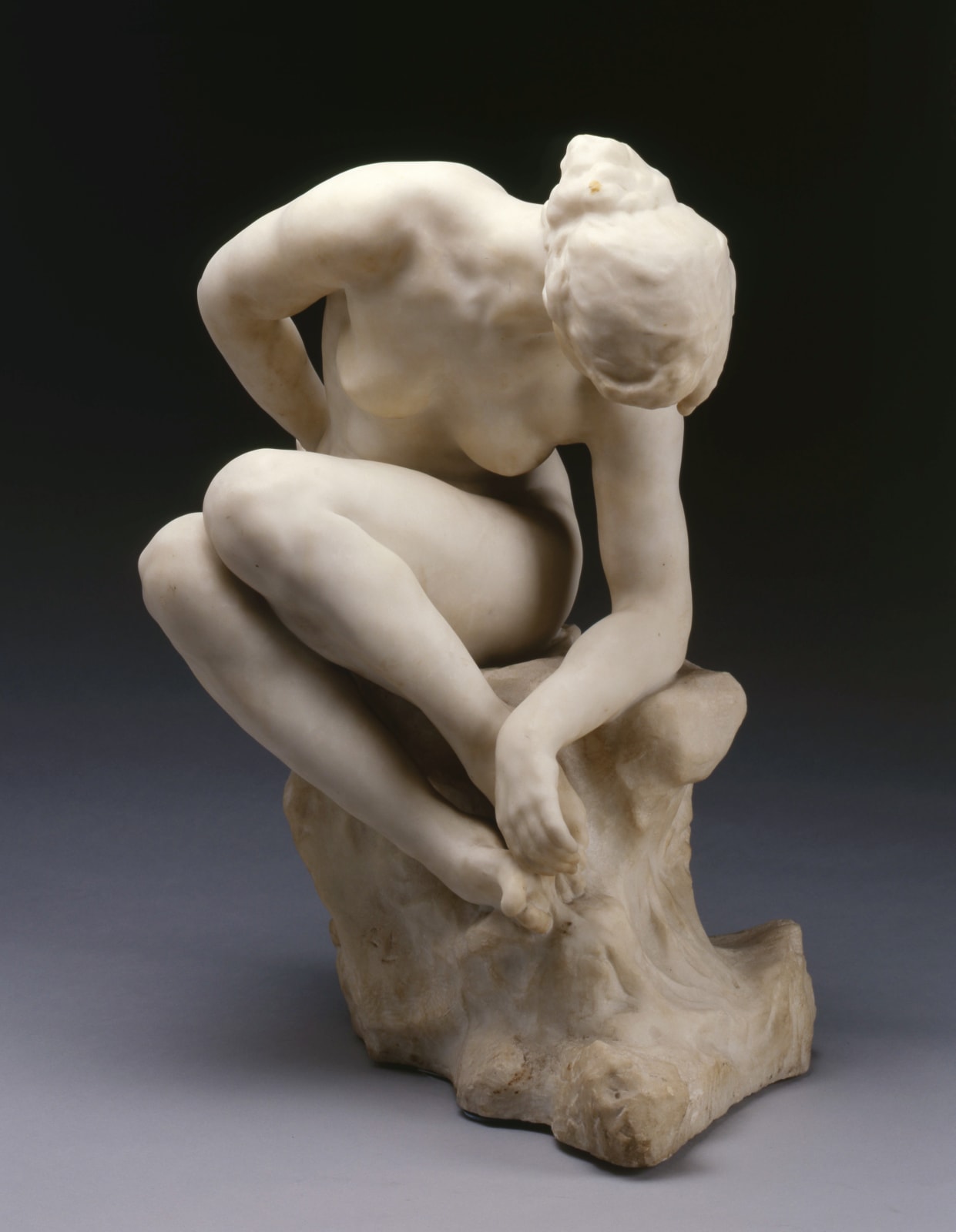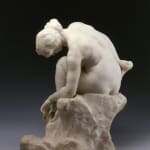Exhibitions
Probably Paris, Société Nationale des Beaux-Arts, 1919 and certainly twice in Paris, circa 1920.
Literature
Raymond Huard and Pierre Maillot, "Jules Desbois", 2000, p. 7, illustrating a photograph of 1935 showing Desbois in his studio beside three other versions of 'La Source'; pp. 36-37, showing a photo of the artist's studio almost certainly featuring this statue on a stand centre right and a plaster model on the far left; p. 44, illustrating a plaster study for 'La Source' in the Musée Jules Desbois, Parçay-les-Pins; p. 69, illustrating another version in stone dated 1918 and p. 106, no. 24 listing four of the recorded versions of 'La Source'.
Jules Desbois (1851-1935)
'La Source'
Marble, signed J Desbois, date circa 1918-19
Height 60.5 cm.
Jules Desbois was among one of the most inspired and innovative sculptors of his day. Best known for his sensual mythological and allegorical figures, he also created stunning portraits, monuments and an array of small decorative objects. As here his work was distinguished by an exaggerated realism and dynamic energy that combined the monumentality of the Renaissance masters, the emotions of the Symbolists and flowing forms of the emerging Art Nouveau movement. At times his sculpture has been compared to the work of his friend Auguste Rodin (1840-1917), with whom he collaborated on a number of important projects. Like Rodin, Desbois endeavoured to explore the physical and emotional expressions of the human form resulting in a powerful series of figure groups that described such aspects as love and pathos, youth and old age as well as life and death. Rodin undoubtedly recognised Desbois's phenomenal talent and in tribute commented that 'should he himself pass away, you still have Desbois'.
This beautiful marble statue, dating from circa 1918-19, is an important and exciting rediscovery, which until now had been considered lost. Raymond Huard, Dubois's co-biographer and Sophie Weygand, the curator of Musée Jules Desbois, Parçay-les-Pins are both equally delighted by its reappearance especially as it was such an important subject in the artist's oeuvre. In a recent conversation with M. Huard, the author asserted that at the time of writing he knew that the marble had existed and that it was exhibited twice in Paris circa 1920. However because he had no specific documentation relating to the work such as an inventory of the artist's sculptures or a specific photograph of the marble he did not list it in his publication. However Sophie Weygand agrees that the marble almost certainly features in a photograph of the artist's studio, where it was placed on a stand below Desbois's bust of Rodin (R. Huard and P. Maillot, pp. 36-7). The reproduction in the book has cut off the right hand side of the original photograph, which included a further large plaster model on the far right. She also notes that after the artist's death the three versions went to the Musée d'Angers, Saumur and Tours while several smaller studies went to the artist's family. After this nothing was known of the marble until its recent discovery.
Dubois worked on La Source for many years producing a number of different versions in various media between 1913-19. In a letter to Rodin dated 1913 he invited his friend to come and view the preliminary study for the subject. The present marble can be considered a culmination of his devotion to the subject, executed between 1918-19 to mark the end of the First World War. The Musée Jules Desbois owns a preliminary patinated red brown plaster model for the work, (29.7 x 18.9 x 19.9 cm; presented as a gift by Madame Besse), which has recently featured on one of the museum's illustrated bulletins. The Musée Dubois also owns another small alternative study of the subject. More recently the museum has acquired a larger stone version (dated 1918, 125 x 85 x 65 cm; previously at Le Chambon Feugerolles, Loire). This latter version differs slightly from here, mainly in the respect that the model's hair falls down onto her shoulder. In his book, M. Huard noted that the stone version was exhibited at the Société Nationale des Beaux-Arts, Paris in 1919. However the reappearance of the present marble has thrown doubt on this assertion since it may have been the marble and not the stone version that was shown in 1919. A photograph of the artist taken shortly before his death, posthumously reproduced in the journal "Les Angevins de Paris", 1936 showed the artist with three other versions of the subject, each with the models hair falling onto her shoulder. Other known versions include a large plaster model (125 x 85 x 65 cm) in the Musée des Beaux-Arts at Angers.
Between 1921-29 the fondeur, A. A. Hébrard produced at least six bronze versions of 'La Source'. The bronzes directly correspond with the marble, both in their design and size. Each measures 60 cm, i.e. slightly smaller than the marble, which would take into account shrinkage during the firing process. One of the bronzes is now housed at Musée du Dr Faure, Aix-les-Bains, once owned by Dr Jean Faure, whose collection of Impressionist works also include sculptures by Rodin and Desbois.
The artist only created a limited number of marble statues, which are rarely seen on the open market. 'La Source' is one of Desbois's most beautiful and important female allegorical figures, representing a flash of inspiration during the latter years of his career. Its modelling and treatment bares close comparison with the sculptures of Rodin and in turn looks back to the work of the great Renaissance master, Michelangelo. In particular the complicated pose and exaggerated monumentality bare a striking resemblance to a number of Michelangelo statues as well as the sibyls and foreshortened figures on his painted Sistine Ceiling. Rodin also created works with similar poses and likewise contrasted the smooth finished female form emerging from a still uncut rough base. Considering their close relationship it is likely that Desbois knew Rodin's versions of 'La Source', (terracotta c. 1867 and marble, 1900).



